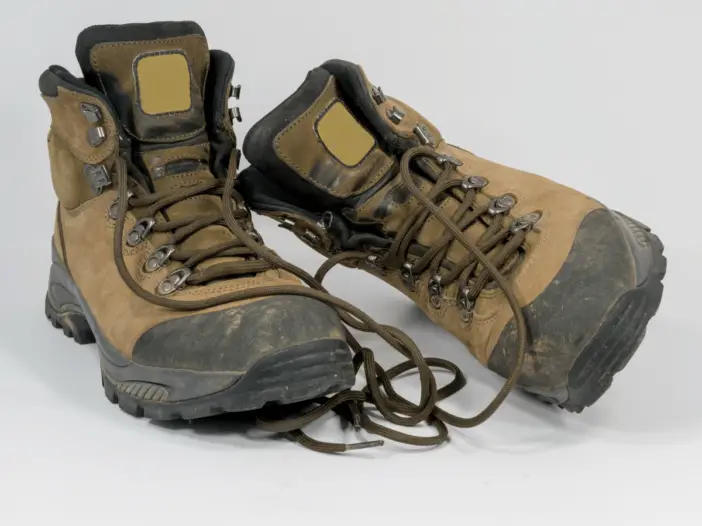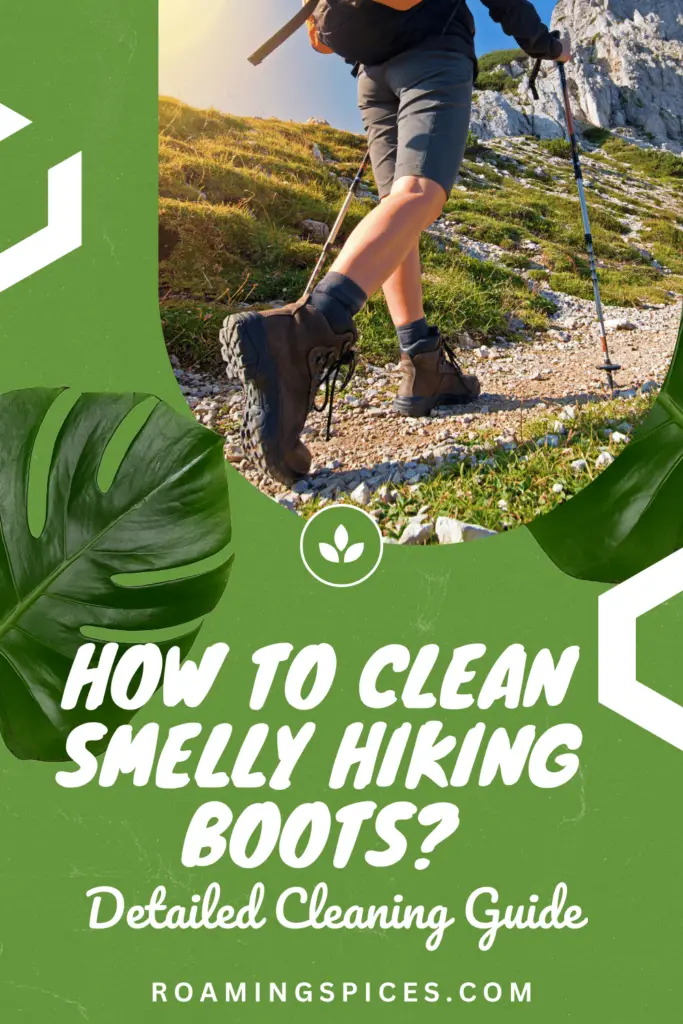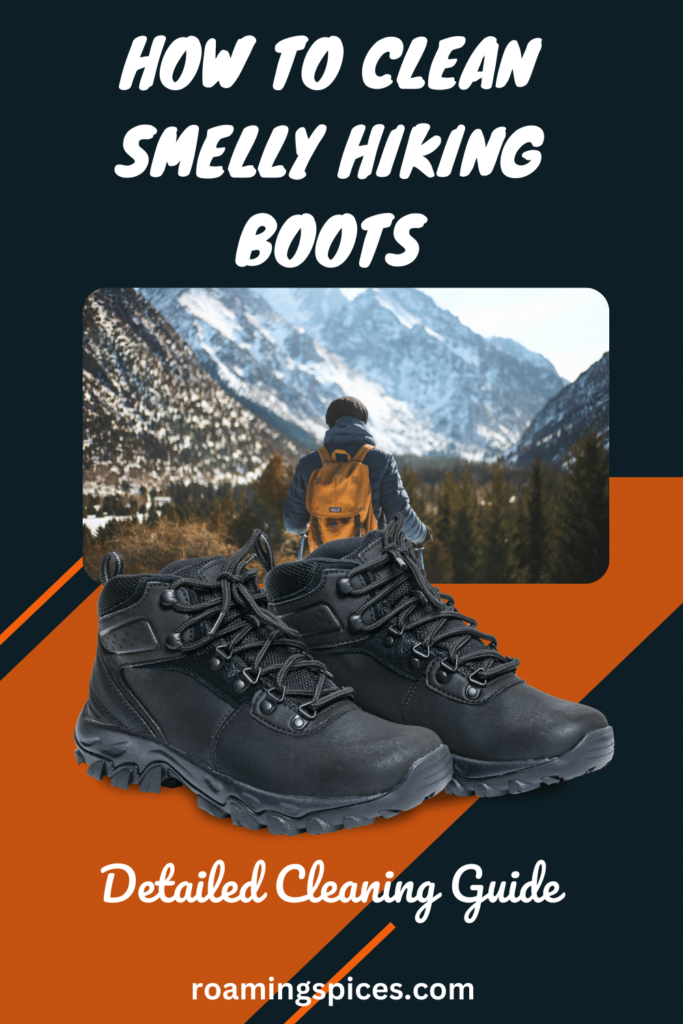
Hiking Tips
Worry not if you’ve ever embarked on a thrilling hike, only to be greeted by the unpleasant scent of smelly boots. In this guide, we’ll show you exactly how to clean smelly hiking boots and ensure your next adventure is filled with fresh and odour-free steps
Why Hiking Boots Smell and How Best to Clean Them
Hiking is an exhilarating and adventurous pursuit, allowing us to connect with nature’s beauty while testing our physical limits. However, the rugged trails and demanding terrain often leave our trusty hiking boots battered and smelly. The odorous aftermath of a challenging hike can be unpleasant and, if not addressed, may leave your boots with a long-lasting stench.
In this comprehensive guide, we will delve into the art of rejuvenating your smelly hiking boots, ensuring they not only smell fresh but also perform their best on your next wilderness exploration.
We’ll explore the reasons behind the unpleasant odour, and the essential cleaning supplies you’ll need, and provide a step-by-step tutorial on effectively banishing the stench.
By the time you’ve finished reading, you’ll have the knowledge and techniques to tackle even the most stubborn boot odours. Say goodbye to smelly hiking boots and hello to more enjoyable, aromatic outdoor adventures!
Why Do Hiking Boots Smell?
Hiking boots are prone to developing unpleasant odours due to a combination of factors related to their usage in rugged outdoor environments. Understanding these reasons is crucial for effectively addressing and preventing boot odour.
Moisture Accumulation: Hiking often involves traversing wet and muddy terrain, leading to moisture seeping into your boots. Moist conditions create an ideal environment for bacteria and fungi to thrive. These microorganisms break down sweat, skin cells, and other organic matter, releasing foul-smelling compounds.
Sweat and Heat: As you hike, your feet naturally sweat to regulate body temperature. If your boots don’t provide adequate breathability or moisture-wicking properties, sweat can accumulate inside, contributing to odour buildup.
Dirt and Debris: Trails are often dusty and dirty, and dirt and debris can stick to your boots as you hike. This mixture can trap moisture and create a breeding ground for odour-causing microbes.
Inadequate Drying: After a hike, moisture remains inside if your boots aren’t properly dried. This trapped moisture nurtures bacteria and fungi, leading to persistent odours.
Material Absorption: The materials used in hiking boots, such as leather or synthetic fabrics, can absorb and retain odours over time. This happens as these materials interact with sweat and other substances.
Extended Use: The longer you use your hiking boots without cleaning and maintenance, the more likely odours will develop. Regular cleaning and proper care can help prevent the accumulation of smells.
Understanding these factors and taking proactive measures to address them, like regular cleaning and ensuring proper ventilation, is essential to keeping your hiking boots smelling fresh and ready for your next adventure.
Gathering the Necessary Cleaning Supplies
This is the first step in revitalising your smelly hiking boots. Having the right tools at your disposal ensures a more effective and efficient cleaning process.
Brush or Bristle Brush: Start with a brush to remove loose dirt and debris from the exterior of your boots. A bristle brush, especially one with stiff bristles, can be invaluable.
Mild Detergent or Boot Cleaner: Use a mild detergent specifically designed for outdoor gear or a specialised boot cleaner to clean the boot’s surface. Avoid harsh chemicals that could damage the materials.
Warm Water: You’ll need warm water for cleaning, so ensure you have a basin or sink ready.
Soft Cloth or Sponge: A soft cloth or sponge helps to apply the cleaning solution and gently scrub your boots without causing any damage.
Toothbrush: A toothbrush is handy for reaching into crevices and seams that are difficult to clean with larger brushes.
Towel: Keep a clean towel nearby to dry your boots after cleaning and rinsing.
Odour Eliminator: Consider using an odour eliminator or baking soda to tackle persistent smells.
By ensuring you have these cleaning supplies on hand, you’ll be well-prepared to clean your smelly hiking boots effectively, helping them regain their freshness and extend their lifespan.
How to Clean Smelly Hiking Boots: The Step-by-Step Process
Cleaning smelly hiking boots requires a systematic approach to address odour and dirt accumulation. Here’s a comprehensive step-by-step guide on how to clean smelly hiking boots:
a. Removing Dirt and Debris
Begin by removing loose dirt and debris from your boots. Use a brush or bristle brush to gently scrub the exterior, focusing on the sole, crevices, and seams. Pay attention to the treads and grooves, ensuring they are free of mud and gravel. Knock the boots together to dislodge any remaining debris.
b. Treating Odor-Causing Bacteria and Fungi
Mix a mild detergent or specialised boot cleaner with warm water to combat odour. Use a soft cloth or sponge to apply the solution to the interior of your boots. Scrub gently to clean the inner surfaces where sweat and bacteria accumulate. Consider using a mixture of water and white vinegar or a commercial odour eliminator for persistent odours. These will help kill bacteria and neutralise odours.
c. Cleaning the Insoles
Remove the insoles if they are detachable. Clean them separately by washing them with the same soapy water mixture used for the interior. Rinse them thoroughly and allow them to air dry completely. If your insoles are not removable, wipe them down with a cloth soaked in the cleaning solution.
d. Washing the Laces
Take the laces off your boots. You can either hand wash them or use a washing machine if they are machine-safe. Soak them in a bowl with the cleaning solution, scrub if needed, and rinse thoroughly. Let the laces air dry completely before reattaching them.
e. Cleaning the Outer Surface
Apply the soapy water mixture and scrub gently to remove any stains or remaining dirt. Pay attention to scuff marks and any other blemishes. Rinse with clean water to remove soap residue.
f. Drying Your Hiking Boots Properly
Proper drying is essential to prevent future odour problems. Avoid direct heat sources like radiators or heaters, as they can damage the boot materials. Instead, stuff your boots with crumpled newspaper or use boot shapers to maintain their shape and absorb moisture.
Allow them to air dry in a well-ventilated area, away from direct sunlight. This process may take several hours or even overnight. Ensure they are completely dry before storing or wearing them again.
Following these steps meticulously will not only rid your hiking boots of unpleasant odours but also extend their lifespan, ensuring they continue to support you on your outdoor adventures.
Tips for Preventing Smelly Hiking Boots
Preventing smelly hiking boots is as important as cleaning them. Here are some valuable tips to help you maintain fresh and odour-free footwear:
Choose Moisture-Wicking Socks: Invest in moisture-wicking socks made of materials like merino wool or synthetic blends. These socks help keep your feet dry by wicking away sweat and reducing the moisture that fosters odour.
Proper Boot Fit: Ensure your hiking boots fit correctly. A well-fitting boot allows for adequate airflow, reducing moisture buildup.
Alternate Footwear: Avoid wearing the same hiking boots on consecutive days. Give them time to air out and fully dry between uses.
Regular Cleaning: Develop a routine of cleaning your boots after each hike, even if they don’t appear dirty. This prevents dirt and sweat from accumulating, becoming a breeding ground for odour-causing bacteria.
Use Foot Powder or Antiperspirant: Applying foot powder or antiperspirant on your feet before putting on socks can help reduce sweating and odour.
Dry Feet Before Wearing Boots: Ensure your feet are completely dry before wearing hiking boots as moisture from wet feet can transfer to the boots.
Store Boots Properly: Store your boots in a cool, dry place with good ventilation. Avoid sealing them in airtight containers, which can trap moisture and odours.
Rotate Insoles: If your boots have removable insoles, consider rotating them with spare insoles to allow for drying and reduce odour buildup.
Regular Maintenance: Inspect your boots for wear and tear signs and promptly address any issues. Damaged boots can accumulate odours more easily.
By incorporating these preventative measures into your hiking routine, you can significantly reduce the likelihood of smelly hiking boots, ensuring a more pleasant and comfortable experience on the trail.
Dealing with Persistent Odors
Persistent odours in hiking boots can be stubborn, but with some targeted efforts, you can effectively tackle them:
Baking Soda: Sprinkle a generous amount of baking soda into your dry boots and leave it overnight. Baking soda is excellent at absorbing odours. Shake out the excess powder in the morning.
Activated Charcoal: Place activated charcoal pouches or inserts in your boots when storing them. Charcoal is a natural odour absorber that can help eliminate persistent smells over time.
Freezing Method: Seal your boots in a plastic bag and place them in the freezer overnight. Cold temperatures can kill odour-causing bacteria. Just let the boots thaw and air out before wearing them again.
Sunlight: Allow your boots to air out in direct sunlight. UV rays can help kill bacteria and reduce odours.
Tea Bags: Put unused, dry tea bags (particularly ones with strong aromas like mint or lavender) in your boots when storing them. Tea bags can absorb odours and leave a pleasant scent.
Commercial Odour Sprays: Consider using specialised odour-eliminating sprays or powders for shoes and boots. Follow the product instructions carefully.
Consult a Professional: If all else fails, consult a professional cobbler or footwear specialist. They may have advanced cleaning and deodorising techniques to revive your boots.
Remember that persistence and patience are key when dealing with persistent odours. It might take a combination of these methods and some time to eliminate the smell from your hiking boots. Regular cleaning and preventative measures can also help prevent odours from returning.
Storing Hiking Boots to Avoid Smell Buildup
Storing hiking boots is crucial to prevent odour buildup and maintain longevity. Here are essential tips for storing your boots effectively:
Clean and Dry: Ensure your boots are completely clean and dry before storing. Remove any dirt, mud, or moisture accumulated during your hike. Cleaning them prevents odours from developing over time.
Loosen Laces: Loosen the laces or even remove them altogether. This allows air to circulate inside the boots and prevents pressure points that could lead to misshapen footwear.
Use Boot Trees or Shapers: Invest in boot trees or shapers to maintain the boots’ shape and keep them from collapsing. These aids also help with proper ventilation.
Choose a Cool, Dry Location: Store your boots in a cool, dry place with good air circulation. Avoid damp or humid areas, as moisture can promote the growth of odour-causing bacteria and fungi.
Avoid Airtight Containers: Never seal your boots in airtight bags or containers for extended periods, as this can trap moisture and cause unpleasant odours to fester.
Rotate Footwear: If you have multiple hiking boots, consider rotating them regularly. This allows each pair to air out between uses, reducing the risk of odours.
Following these storage guidelines, you can ensure your hiking boots remain fresh and odour-free, ready to accompany you on your next outdoor adventure.
When to Consider Professional Cleaning
Professional cleaning for your smelly hiking boots becomes a consideration when removing the odour at home proves unsuccessful. Here are some scenarios that indicate it might be time to seek professional assistance:
Persistent and Intense Odor: If the odour persists despite your best cleaning attempts and continues to be overpowering, it’s a sign that deep-seated contaminants or bacteria may require professional attention.
Specialised Materials: Hiking boots often contain leather, Gore-Tex, or specialised fabric blends. If you need help cleaning these materials properly, a professional cobbler or cleaner can ensure the correct treatment.
Visible Damage: If your boots have visible damage, such as separated soles, torn stitching, or extensive wear, professionals can assess and repair these issues as part of the cleaning process.
Limited Success with Home Remedies: When home remedies and store-bought cleaning products have limited success, it may be time to consult experts with access to specialised equipment and cleaning solutions.
Valuable or Sentimental Boots: If your hiking boots hold sentimental value or are of high quality and you want to ensure they’re treated with care, a professional cleaning service can provide peace of mind.
Professional cleaning services for hiking boots often combine deep cleaning, odour elimination, and material restoration. They can bring new life to your beloved boots, making them not only odour-free but also ready for many more outdoor adventures.
How to Clean Smelly Hiking Boots – Conclusion
Knowing how to clean smelly hiking boots is a valuable skill for any outdoor enthusiast. Your hiking boots, faithful companions on rugged trails, can develop unpleasant odours over time due to moisture, dirt, and bacteria accumulation.
However, armed with the knowledge and techniques outlined in this guide, you can effectively combat these odours and keep your boots fresh and ready for your next adventure.
Remember the importance of regular maintenance, which includes removing dirt, treating odour-causing bacteria, and keeping your boots clean and dry. Prevention is equally crucial, so consider implementing tips like wearing moisture-wicking socks and allowing your boots to air out between uses.
When persistent odours or specialised materials are involved, don’t hesitate to seek professional cleaning services for a thorough and expert restoration.
By following these steps and making cleanliness and odour control a routine part of your outdoor gear care, you can ensure that your hiking boots provide reliable support on the trails and offer the pleasant experience of fresh-smelling footwear, enhancing your overall hiking enjoyment.
Like Our Article? Please Pin it!



Leave a Reply